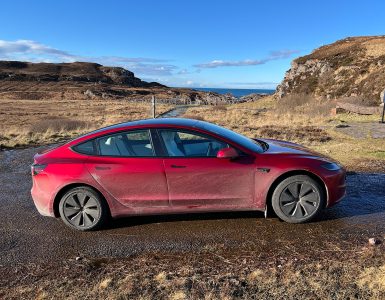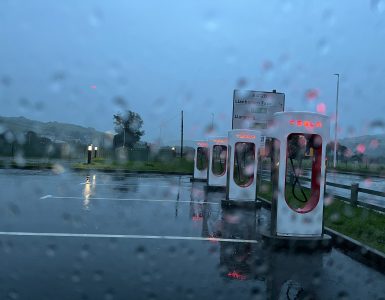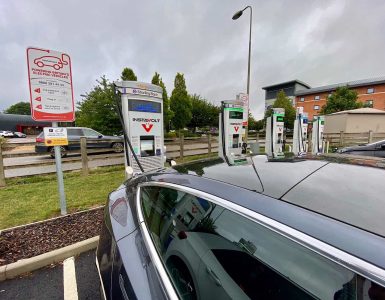Doing longer trips in an EV
Longer journeys are meant to be the achilles heel of EV’s but in reality having done medium distance trips, with the right EV, it just requires a slight adjustment to your trip plans. In fact having a few short charging stops that allow for a tea and toilet stop often mean you are less tired on arrival after a long journey.
The right EV for longer trips
There are 3 main factors that can help make EV trips easy.
- the range of the car
- the speed it can charge and
- the third is the choice & ease of charging in the area you travel through
Ideal battery size
You might think the longest range EVs are the ones with the biggest batteries. The trouble is if you start with an inefficient car like a 2.5 ton Audi e-tron 55, trying to make it go further with a bigger battery just adds even more weight, so it travels less far per kW, which gives you less range.
Updated in Sept 2021 – For example the benchmark Tesla Model 3 dual motor uses around 278Wh per mile which is very efficient for its size and performance. This means it can travel 3.6 miles for every kW in the 74kW battery. 74 x 3.6 is 266 miles. This figure is what our car has done over 2 years and 16,000 miles in a mix of very slow London traffic, motorway and country A & B roads. We’ve also used it for our “EV daytrips” including to London to Cornwall, Wales, and Scotland and back in a day.
On our Model 3 Performance, depending on:
- how warm it is outside
- whether the car has to heat its battery at the beginning of the trip
- how fast you drive
- if you are using aircon, lights, wipers etc
efficiency on longer drives is 220Wh per miles to 325Wh per mile. So thats a best possible of 336 miles in ideal summer conditions or a worst of 227 miles using heating on a fast winter drive.
By contrast according to EV Database the Audi e-tron 55 has an 85kWh battery but uses 375Wh per mile. That means in average conditions the Audi will only get you 226 miles and according to US EPA tests that might turn out to be nearer 200 miles.
What makes our figures better than average for a Model 3 Performance…
Our Model 3 has 18” wheels with aero covers that provide about 20 more miles of range than the heavier, less aerodynamic alloy wheels on faster trips
What makes our figures worse than average for a Model 3 Performance…
Diesel vehicles. I am fairly obsessive about not breathing in the toxic stench from diesels.. in fact I can smell many of them from 20 metres away ( that over 4 car lengths away). As a result I tend to recirculate the air and have to use power hungry aircon or the model 3 windows mist up pretty fast esp in cooler weather. So diesels cost me a lot in energy especially in very slow London traffic.
How far will 100kWh of battery get you at different efficiency rates?
| Efficiency in Wh/mile | Miles per kW (1000 W) | Range with a 100kW battery* |
| 200 Best | 5 | 500 miles |
| 250 | 4 | 400 miles |
| 333 | 3 | 300 miles |
| 500 Worst | 2 | 200 miles |
If you want an idea of what the range of an electric car is in the real world take 20% off the European NEDC or WLTP range numbers. American EPA range figures are usually more realistic but otherwise if you see an owner ask them. The one Caveat is Tesla EPA figures do seem a little more optimistic on Tesla’s than other makes, certainly in cooler weather.
The goldilocks battery size (not too big not too small, just right) seems to be 50 to 77kW with existing lithium ion batteries. The star EVs in this sweet spot are the Tesla Model 3, Hyundai Kona and Kia Niro. They all also weigh under 1.9 tons.
Finally if you want to travel longer distances, we can’t recommend the current Nissan Leaf or Leaf+. For reasons known only to Nissan this EV can’t heat or cool its battery. As a result you can only charge it fast once in a day – your next charge would take hours due to this “rapidgate” issue. That said if you charge nearly fully the day before you leave then use a slow charge to top up then a Leaf+ can still get a long distance in a day. See Carwow video below.
Charging speed
This is important because it will decide how much time you’ll spend charging. The question is how do measure it. The simple way is in kW. Remember the maximum charging speed can never exceed the maximum of either the car OR the charger. No cars will get more than 50kW out of a 50kW charger and there’s no point in searching out a 350kW charging if your car only charges at up to 50kW.
The other way to measure charging speed is in miles per hour. That’s not the speed you’re driving – its how many miles you of range you could add in an hour of charging. This takes into account the number of kW and how far your car can get with that power. For example in the table above if 2 cars both add 100kW of power but one can go 4 miles per Wh thats 400 miles per hour while an EV that can only go 200 miles with the same 100 kW has a charging speed of only 200 mph.
As you can see driving a less efficient EV then will not only cost more money (just like a combustion engine car with poor economy) but you’ll also be spending a lot longer charging to go the same distance.
A rule of thumb is choose a car with80kW or more DC charging speed for longer trips and/or to aim for a charging rate thats double the cars battery size or more. This should keep most charging stops to half an hour or less.
Charging Networks
Tesla
Driving a Tesla provides a big advantage over other EV’s because Tesla have a network of fast “Superchargers” in most regions of the UK that are reliable, have enough charging bays that you don’t often have to wait and that charge at between 120kW and 250kW. They tend to be on or near Motorways.
In addition there are lots of slower Tesla destination chargers where you can also plug in at restaurants, hotels and other places you might spend time. The assurance that when you get to a charger you just plug in and it will work is a big plus. Your Tesla will also plan your route to include all the charging stops you need.
Finally Tesla have a big cost advantage as superchargers “currently” cost 24p per kWh. That means it costs around £68 to drive 1,000 miles in our Model 3. Many public chargers cost 30p, 35p or 40p which would bring the cost of the same 1,000 miles to £85, £100 or £114 in the same car using these public chargers. So while the Tesla is efficient and sometimes will need to use more expensive public charging, an equally efficient car like a Kia e-Niro will cost pay more on the same trip.
Public Charging Networks
From our own experience from what we have seen and heard from EV owners, the number of charging points is not the issue.
We recommend using a map like ZapMap, “A better routeplanner” or Wattsapp to help you find chargers easily. They are all available on as websites and mobile apps.
On longer trips in a new area of the country you may be primarily using chargers from Networks you are using for the first time. We would strongly recommend using chargers that take contactless payment. You may be able to charge for less money on chargers that require an app download or a website login but you could spend 15-30 mins of faffing with signups and downloads etc before your charging can even begin. Networks like instavolt and Osprey and Instavolt are 100% contactless.
The issues are:
- Reliability – Some non Tesla charging points are unreliable so you’ll arrive at charging points, connect and either nothing happens or you’ll be on the phone for 20 mins trying to get it working. Ecotricity motorway chargers have a particularly poor reliability reputation. See Zapmap for user feedback on working and non working chargers
- Payment – Paying for charging should just involve putting your debit card in a machine or tapping and getting charged for the kW you use. As easy as buying petrol.
Sadly some chargers require you to download an app for each provider, or pay a membership fee that requires use of a dedicated RFID card. Some others bill by the minute so the slower the charger runs the more you pay! When was the last time a petrol purchase required you to enter your name, address, email and debit card details each time you charge - Paying contactless with a debit card is coming especially on new faster chargers from Ionity (very expensive unless your car gives you reduced rates) and BP chargemaster along with 100% contactless networks like Osprey and Instavolt. Some providers are also finally joining together so you only have to use one app for several providers.
- Speeds listed by silly labels not actual speed. Non Tesla chargers use rather silly monickers like fast, rapid, ultra rapid etc. In reality when you’re on the road and needing a charger just want the charging speed and per kW clearly indicated.
In reality 100kW or more is ideal on long journeys but until the start of 2019 the fastest non Tesla chargers were 50kW. This is at last changing “rapidly” with BP chargemaster installing 150kW and Ionity bringing 350kW charging to the UK but even by September 2020 the majority of new DC chargers being installed can only manage 50kW - Regions with fewer charging options. In some parts of the UK getting a 100kW charge or more is hard to come by. This does not mean you will be stranded. It does mean you are more likely to be using the many slow chargers more often, entering your details to pay etc. If these are near where you stay or visit this doesn’t have to be disruptive but you’ll be adding 20 to 50 miles of range per hour rather than 400.
- Price. There are some chargers that are free including in some supermarket car parks but as a rule of thumb 25-35p a kWh is a reasonable rate. Beware of chargers that bill by the minute or have a fixed connection charge. Some provide power very slowly (or not at all) so the price per kWh can be massive. Price per kWh should be clearly displayed like a at petrol stations before you plug in. Ionity has announced that it will switch to transparent per kWh billing for its 350kW chargers. Sadly the extortionate rate of £0.69 a kW will cost you more per mile than a petrol car. Several car companies own Ionity and is possible more normal pricing will be offered to owners of their cars. If so the high standard price may be to keep chargers available for BMW, Mercedes, VW, Audi, Porsche and Ford owners. reasonable cost charging on Ionity could be a bonus for the new VW iD3 and Ford Mach e that arrive later in 2020
- Membership of a public network. A non Tesla can get round higher charging cost by paying a subscription to one charging network in order to get cheaper rates but you may have to charge about 3,000 miles a year worth before that makes you better off and your subscription network may not have quick charging in the areas you travel to!
Overall with a little awareness and planning you can deal with the long journeys fairly painlessly. The main tips are:
- on most through routes there should be faster charging options so charge little and often
- heading to a region like some parts of Wales where there are fewer 100+ kW options? Well make sure you make the most of the last quick charging options so that you have more time & more range to hunt out local chargers at your destination. If possible, avoid arriving at your destination with under 20% in your battery.
- Make sure you know how your car or your phone can guide you to local chargers.
- Before you plan a trip use your car or zapmap or a better route planner to investigate the best charging options near your destination. In some areas one provider will provide most local charging points. If so downloading their payment app and signing up in advance may be easier than standing in the rain with a poor mobile reception when you are in front of their charger. It also means you’ll have a better idea how much you will be billed.
- if you’re really in a bind many hotels, restaurants and supermarkets have chargers for customers. Some are even free and if asked nicely some will let you charge provided you buy a cup of tea etc.
Top tip – Charging a battery gets slower the more full it gets, especially from 80% to 100%. So on a long trip by all means charge to 100% just before you leave but once you are on the road do more frequent but shorter charging stops (charging from 10% to 80%) rather that trying to get the battery full. This approach could radically cut the time you spend charging on a long journey
Planning a EV trip
If you have an EV or are thinking about going electric and want an idea of what charging on a trip will be like then you can plan a trip on a https://abetterrouteplanner.com/
A better route planner lets you plan a route for most EV’s and sets out how many stops and for long to get to your destination most quickly.
Longer trips in a Tesla Model 3
The Tesla Model 3 is, for the moment the ideal EV for longer trips. Why? Well it’s down to:
- long range, excellent efficiency, fast charging and its own reliable and effective charging network where you rarely have to wait to start charging
- for example the dual motor long range versions can deliver over 300 miles of range and 250kW charging that can add 200 miles of range in around 15 minutes*
- Most charging stops at Tesla Superchargers are around 20 to 40 mins and are getting quicker.
Reality check*
- The first UK V3 Tesla supercharger that can charge up a Model 3 at 250kW (up to 1,000 miles of range per hour you charge) was opened at Park Royal in west London. Our experience to date is you get a few seconds over 200kW then it settles at around 180-190. So not as advertised yet but still much quicker than any other EVs for now.
- any EV will charge fastest in reasonably warm weather (17c to 27c) and when the battery is fairly empty (10% to 50% is quickest)
- the last 20% (ie between 80% and 100%) of charge will be very slow.
- For battery longevity and keeping charging times fast it’s recommended on all EVs that you only charge to 100% rarely and for long journeys just before you leave. Once on the road & for normal use only charge to 80%. This may mean more stops but overall time spent charging will be less.
Range Anxiety
While some EVs have longer or shorter range ( and it may drop faster in some situations like on a motorway) once you’ve learnt to find public chargers on your journey range anxiety ceases to exist. If you are in an area where you know the charger locations then it never even crosses your mind.
If you generally recharge before the battery goes below 20% then in most areas you should always have 2nd or even 3rd charging options if a charger is faulty. Obviously the trend towards Tesla style public charging hubs will help here as 1 or 2 chargers being offline is less of an issue when there are 5 or more at 1 location.
Once you adopt this approach then you come to the primary issues.. of which networks give you an easy to use charger offering power quickly and at a reasonable price.
The record distance covered by a fully electric Tesla model 3 including charging stops is 1,728 miles in 24 hrs! Just for reference London to Florence is 994 miles. The record distance was set on German motorway at an average speed of 100mph (72mph including charge time!)
Finally although an EV may sometimes be less convenient it sometimes can be much more convenient. It can be “filling up” while you are asleep at home, or grabbing a coffee on a journey or shopping. How many piston cars can fill up the tank every night before you start your day!







[…] We have our own review of long distance travel in the Model 3 here […]
[…] We also have a review of our first 8,000 miles here and also tips on longer distance trips in an EV […]